Implication for nursing Analysis 2022
VerifiedAdded on 2022/08/25
|12
|3096
|24
AI Summary
hi good day I need your help with concept analysis first concept is spontaneity second is starving each concept 1000 words based on sample attached
Contribute Materials
Your contribution can guide someone’s learning journey. Share your
documents today.
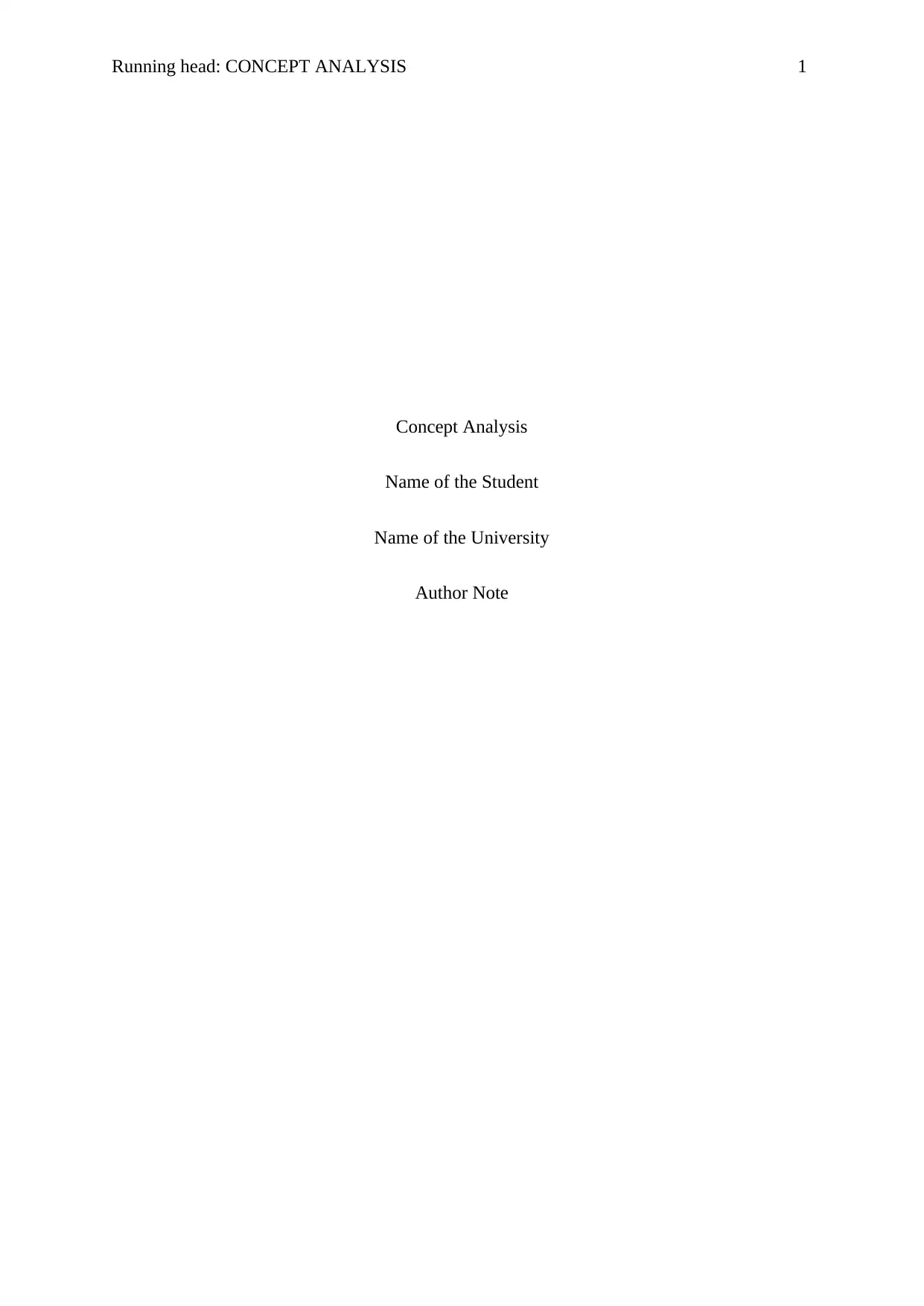
Running head: CONCEPT ANALYSIS 1
Concept Analysis
Name of the Student
Name of the University
Author Note
Concept Analysis
Name of the Student
Name of the University
Author Note
Secure Best Marks with AI Grader
Need help grading? Try our AI Grader for instant feedback on your assignments.
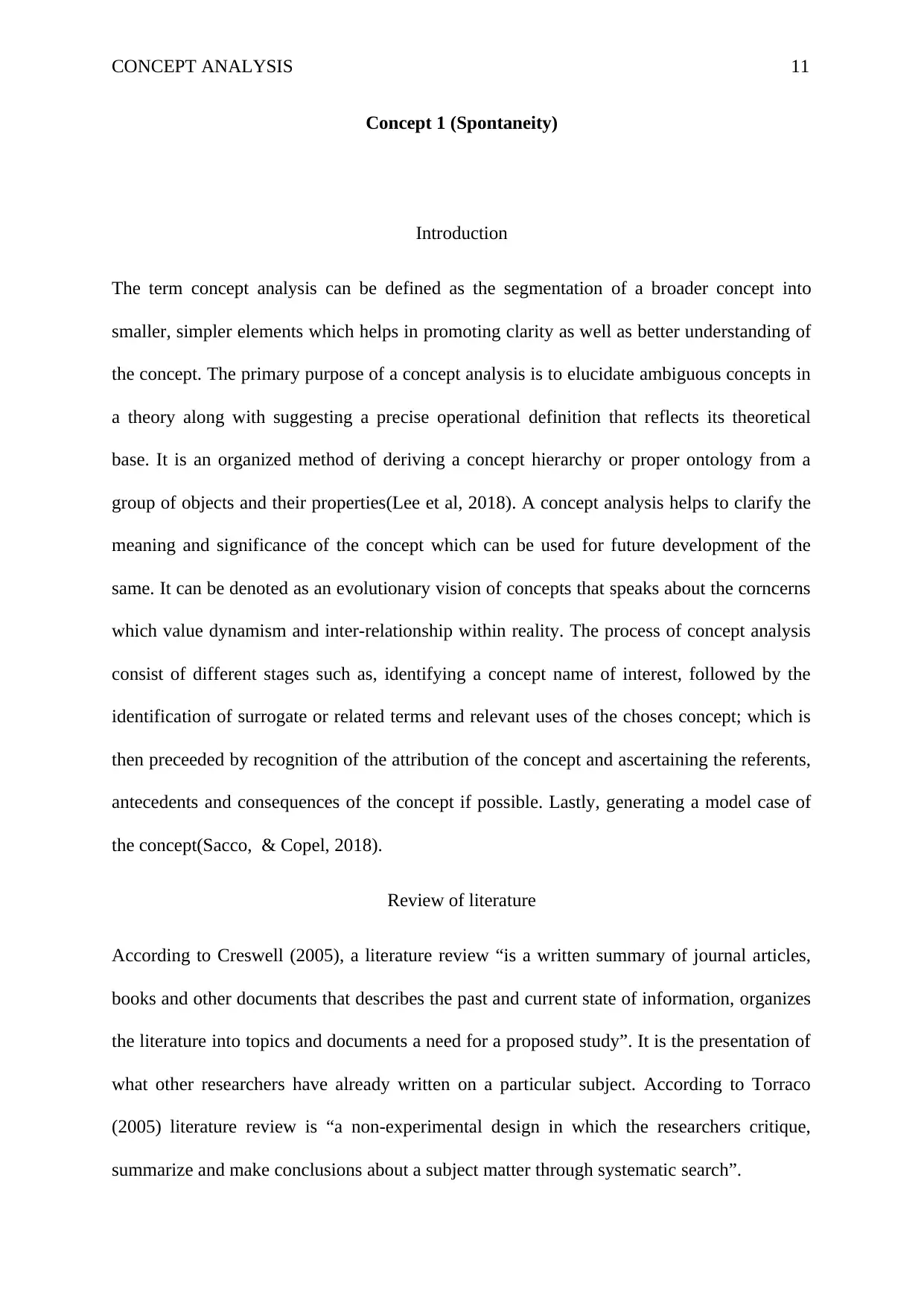
CONCEPT ANALYSIS 11
Concept 1 (Spontaneity)
Introduction
The term concept analysis can be defined as the segmentation of a broader concept into
smaller, simpler elements which helps in promoting clarity as well as better understanding of
the concept. The primary purpose of a concept analysis is to elucidate ambiguous concepts in
a theory along with suggesting a precise operational definition that reflects its theoretical
base. It is an organized method of deriving a concept hierarchy or proper ontology from a
group of objects and their properties(Lee et al, 2018). A concept analysis helps to clarify the
meaning and significance of the concept which can be used for future development of the
same. It can be denoted as an evolutionary vision of concepts that speaks about the corncerns
which value dynamism and inter-relationship within reality. The process of concept analysis
consist of different stages such as, identifying a concept name of interest, followed by the
identification of surrogate or related terms and relevant uses of the choses concept; which is
then preceeded by recognition of the attribution of the concept and ascertaining the referents,
antecedents and consequences of the concept if possible. Lastly, generating a model case of
the concept(Sacco, & Copel, 2018).
Review of literature
According to Creswell (2005), a literature review “is a written summary of journal articles,
books and other documents that describes the past and current state of information, organizes
the literature into topics and documents a need for a proposed study”. It is the presentation of
what other researchers have already written on a particular subject. According to Torraco
(2005) literature review is “a non-experimental design in which the researchers critique,
summarize and make conclusions about a subject matter through systematic search”.
Concept 1 (Spontaneity)
Introduction
The term concept analysis can be defined as the segmentation of a broader concept into
smaller, simpler elements which helps in promoting clarity as well as better understanding of
the concept. The primary purpose of a concept analysis is to elucidate ambiguous concepts in
a theory along with suggesting a precise operational definition that reflects its theoretical
base. It is an organized method of deriving a concept hierarchy or proper ontology from a
group of objects and their properties(Lee et al, 2018). A concept analysis helps to clarify the
meaning and significance of the concept which can be used for future development of the
same. It can be denoted as an evolutionary vision of concepts that speaks about the corncerns
which value dynamism and inter-relationship within reality. The process of concept analysis
consist of different stages such as, identifying a concept name of interest, followed by the
identification of surrogate or related terms and relevant uses of the choses concept; which is
then preceeded by recognition of the attribution of the concept and ascertaining the referents,
antecedents and consequences of the concept if possible. Lastly, generating a model case of
the concept(Sacco, & Copel, 2018).
Review of literature
According to Creswell (2005), a literature review “is a written summary of journal articles,
books and other documents that describes the past and current state of information, organizes
the literature into topics and documents a need for a proposed study”. It is the presentation of
what other researchers have already written on a particular subject. According to Torraco
(2005) literature review is “a non-experimental design in which the researchers critique,
summarize and make conclusions about a subject matter through systematic search”.
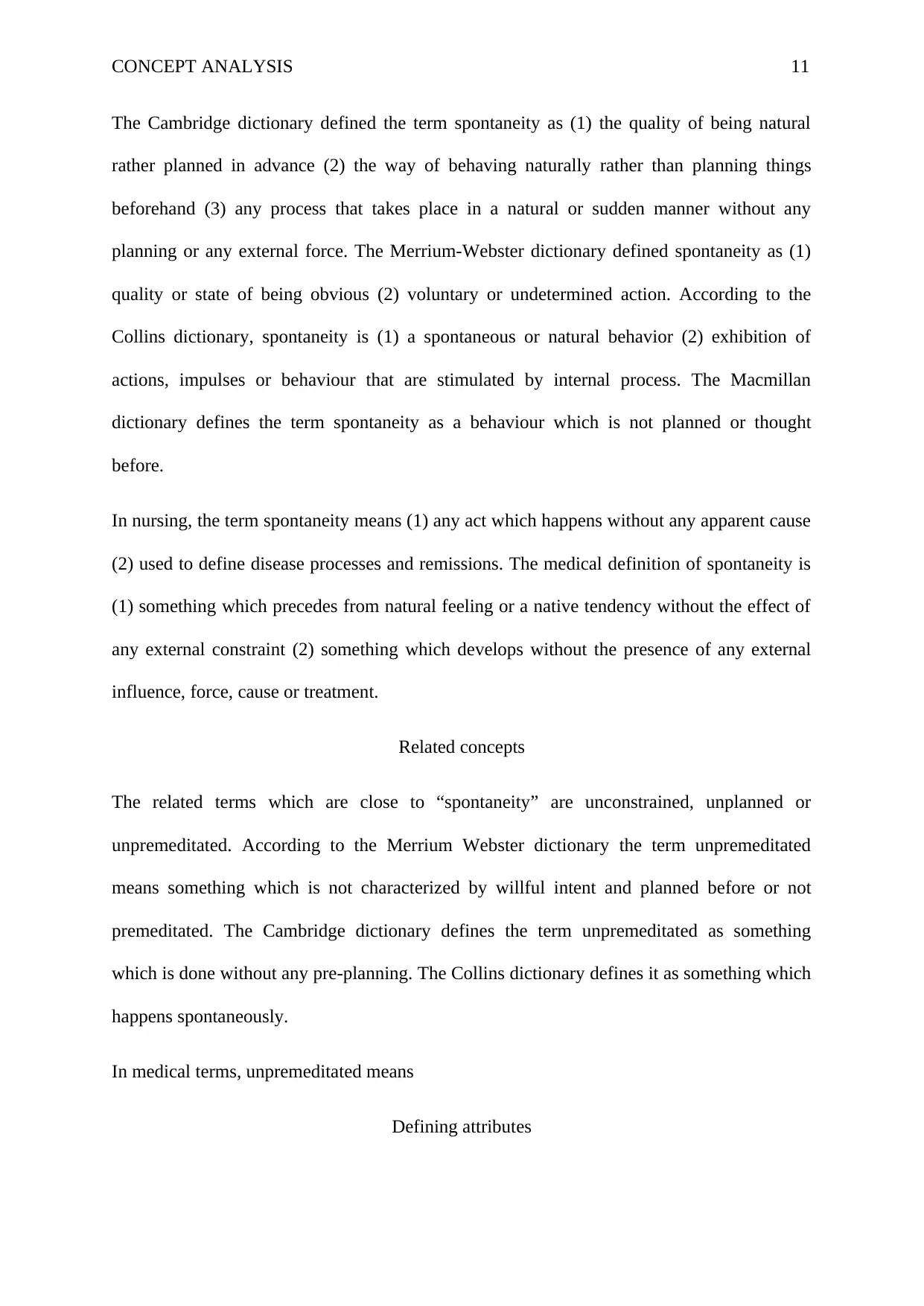
CONCEPT ANALYSIS 11
The Cambridge dictionary defined the term spontaneity as (1) the quality of being natural
rather planned in advance (2) the way of behaving naturally rather than planning things
beforehand (3) any process that takes place in a natural or sudden manner without any
planning or any external force. The Merrium-Webster dictionary defined spontaneity as (1)
quality or state of being obvious (2) voluntary or undetermined action. According to the
Collins dictionary, spontaneity is (1) a spontaneous or natural behavior (2) exhibition of
actions, impulses or behaviour that are stimulated by internal process. The Macmillan
dictionary defines the term spontaneity as a behaviour which is not planned or thought
before.
In nursing, the term spontaneity means (1) any act which happens without any apparent cause
(2) used to define disease processes and remissions. The medical definition of spontaneity is
(1) something which precedes from natural feeling or a native tendency without the effect of
any external constraint (2) something which develops without the presence of any external
influence, force, cause or treatment.
Related concepts
The related terms which are close to “spontaneity” are unconstrained, unplanned or
unpremeditated. According to the Merrium Webster dictionary the term unpremeditated
means something which is not characterized by willful intent and planned before or not
premeditated. The Cambridge dictionary defines the term unpremeditated as something
which is done without any pre-planning. The Collins dictionary defines it as something which
happens spontaneously.
In medical terms, unpremeditated means
Defining attributes
The Cambridge dictionary defined the term spontaneity as (1) the quality of being natural
rather planned in advance (2) the way of behaving naturally rather than planning things
beforehand (3) any process that takes place in a natural or sudden manner without any
planning or any external force. The Merrium-Webster dictionary defined spontaneity as (1)
quality or state of being obvious (2) voluntary or undetermined action. According to the
Collins dictionary, spontaneity is (1) a spontaneous or natural behavior (2) exhibition of
actions, impulses or behaviour that are stimulated by internal process. The Macmillan
dictionary defines the term spontaneity as a behaviour which is not planned or thought
before.
In nursing, the term spontaneity means (1) any act which happens without any apparent cause
(2) used to define disease processes and remissions. The medical definition of spontaneity is
(1) something which precedes from natural feeling or a native tendency without the effect of
any external constraint (2) something which develops without the presence of any external
influence, force, cause or treatment.
Related concepts
The related terms which are close to “spontaneity” are unconstrained, unplanned or
unpremeditated. According to the Merrium Webster dictionary the term unpremeditated
means something which is not characterized by willful intent and planned before or not
premeditated. The Cambridge dictionary defines the term unpremeditated as something
which is done without any pre-planning. The Collins dictionary defines it as something which
happens spontaneously.
In medical terms, unpremeditated means
Defining attributes
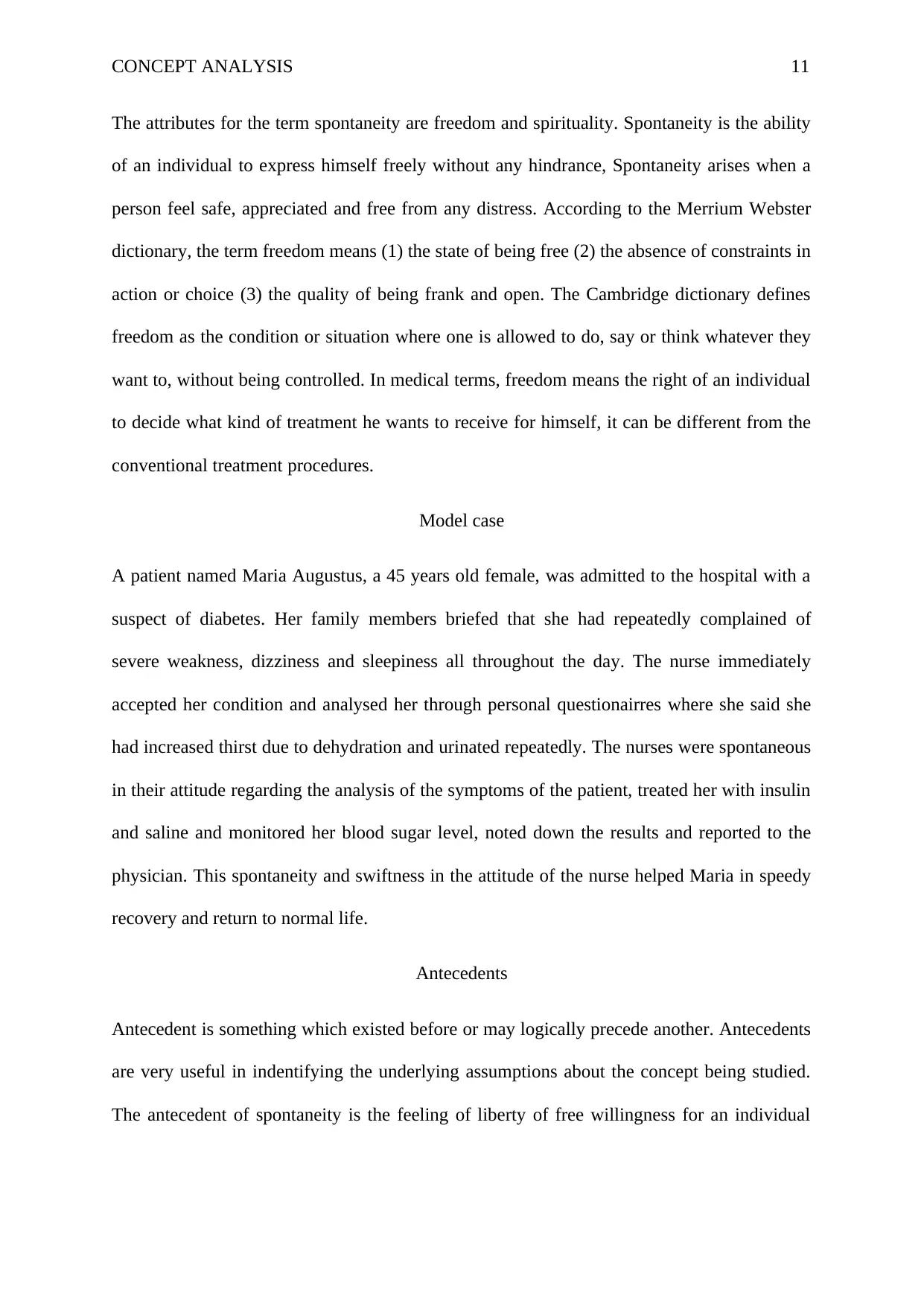
CONCEPT ANALYSIS 11
The attributes for the term spontaneity are freedom and spirituality. Spontaneity is the ability
of an individual to express himself freely without any hindrance, Spontaneity arises when a
person feel safe, appreciated and free from any distress. According to the Merrium Webster
dictionary, the term freedom means (1) the state of being free (2) the absence of constraints in
action or choice (3) the quality of being frank and open. The Cambridge dictionary defines
freedom as the condition or situation where one is allowed to do, say or think whatever they
want to, without being controlled. In medical terms, freedom means the right of an individual
to decide what kind of treatment he wants to receive for himself, it can be different from the
conventional treatment procedures.
Model case
A patient named Maria Augustus, a 45 years old female, was admitted to the hospital with a
suspect of diabetes. Her family members briefed that she had repeatedly complained of
severe weakness, dizziness and sleepiness all throughout the day. The nurse immediately
accepted her condition and analysed her through personal questionairres where she said she
had increased thirst due to dehydration and urinated repeatedly. The nurses were spontaneous
in their attitude regarding the analysis of the symptoms of the patient, treated her with insulin
and saline and monitored her blood sugar level, noted down the results and reported to the
physician. This spontaneity and swiftness in the attitude of the nurse helped Maria in speedy
recovery and return to normal life.
Antecedents
Antecedent is something which existed before or may logically precede another. Antecedents
are very useful in indentifying the underlying assumptions about the concept being studied.
The antecedent of spontaneity is the feeling of liberty of free willingness for an individual
The attributes for the term spontaneity are freedom and spirituality. Spontaneity is the ability
of an individual to express himself freely without any hindrance, Spontaneity arises when a
person feel safe, appreciated and free from any distress. According to the Merrium Webster
dictionary, the term freedom means (1) the state of being free (2) the absence of constraints in
action or choice (3) the quality of being frank and open. The Cambridge dictionary defines
freedom as the condition or situation where one is allowed to do, say or think whatever they
want to, without being controlled. In medical terms, freedom means the right of an individual
to decide what kind of treatment he wants to receive for himself, it can be different from the
conventional treatment procedures.
Model case
A patient named Maria Augustus, a 45 years old female, was admitted to the hospital with a
suspect of diabetes. Her family members briefed that she had repeatedly complained of
severe weakness, dizziness and sleepiness all throughout the day. The nurse immediately
accepted her condition and analysed her through personal questionairres where she said she
had increased thirst due to dehydration and urinated repeatedly. The nurses were spontaneous
in their attitude regarding the analysis of the symptoms of the patient, treated her with insulin
and saline and monitored her blood sugar level, noted down the results and reported to the
physician. This spontaneity and swiftness in the attitude of the nurse helped Maria in speedy
recovery and return to normal life.
Antecedents
Antecedent is something which existed before or may logically precede another. Antecedents
are very useful in indentifying the underlying assumptions about the concept being studied.
The antecedent of spontaneity is the feeling of liberty of free willingness for an individual
Secure Best Marks with AI Grader
Need help grading? Try our AI Grader for instant feedback on your assignments.
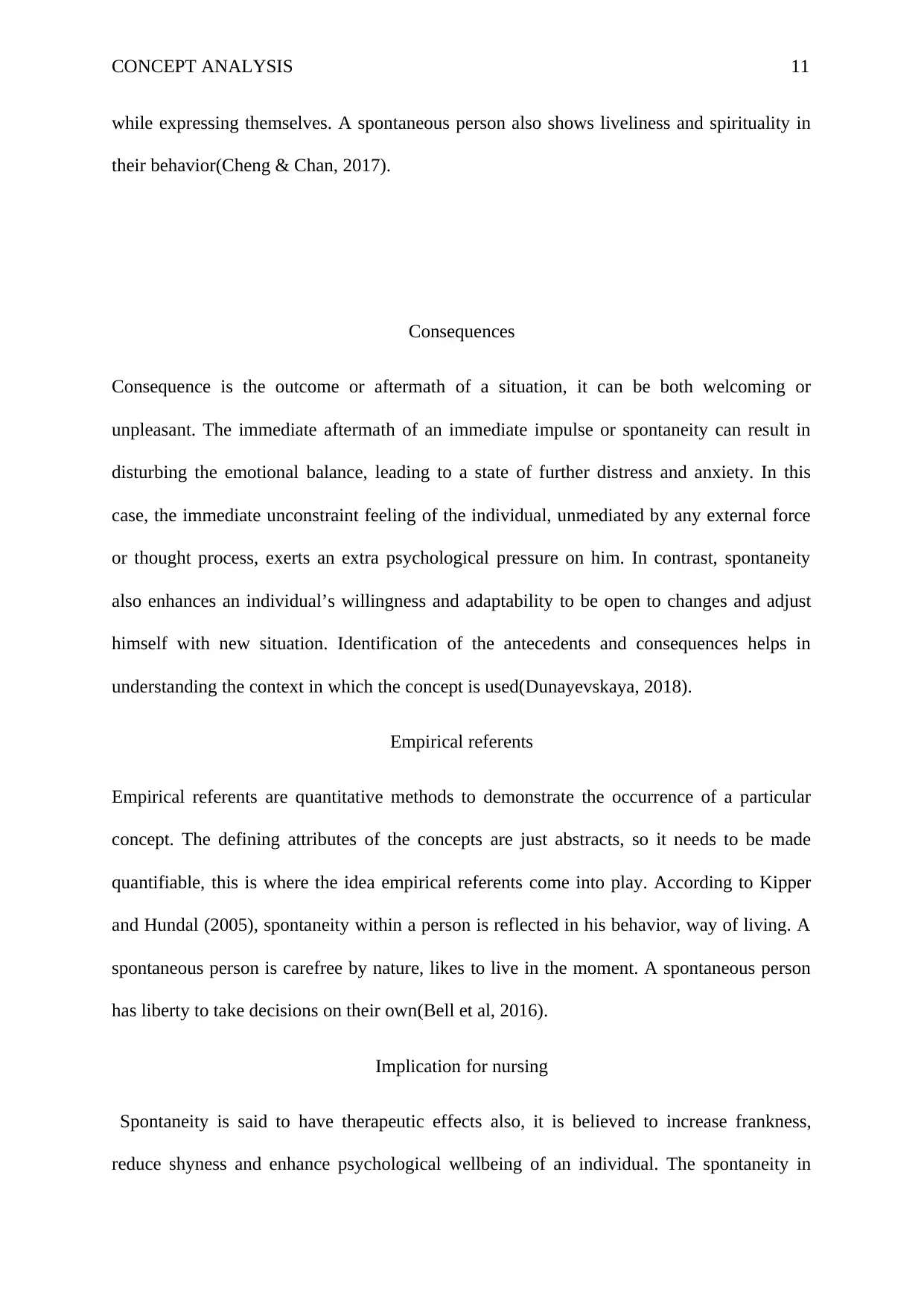
CONCEPT ANALYSIS 11
while expressing themselves. A spontaneous person also shows liveliness and spirituality in
their behavior(Cheng & Chan, 2017).
Consequences
Consequence is the outcome or aftermath of a situation, it can be both welcoming or
unpleasant. The immediate aftermath of an immediate impulse or spontaneity can result in
disturbing the emotional balance, leading to a state of further distress and anxiety. In this
case, the immediate unconstraint feeling of the individual, unmediated by any external force
or thought process, exerts an extra psychological pressure on him. In contrast, spontaneity
also enhances an individual’s willingness and adaptability to be open to changes and adjust
himself with new situation. Identification of the antecedents and consequences helps in
understanding the context in which the concept is used(Dunayevskaya, 2018).
Empirical referents
Empirical referents are quantitative methods to demonstrate the occurrence of a particular
concept. The defining attributes of the concepts are just abstracts, so it needs to be made
quantifiable, this is where the idea empirical referents come into play. According to Kipper
and Hundal (2005), spontaneity within a person is reflected in his behavior, way of living. A
spontaneous person is carefree by nature, likes to live in the moment. A spontaneous person
has liberty to take decisions on their own(Bell et al, 2016).
Implication for nursing
Spontaneity is said to have therapeutic effects also, it is believed to increase frankness,
reduce shyness and enhance psychological wellbeing of an individual. The spontaneity in
while expressing themselves. A spontaneous person also shows liveliness and spirituality in
their behavior(Cheng & Chan, 2017).
Consequences
Consequence is the outcome or aftermath of a situation, it can be both welcoming or
unpleasant. The immediate aftermath of an immediate impulse or spontaneity can result in
disturbing the emotional balance, leading to a state of further distress and anxiety. In this
case, the immediate unconstraint feeling of the individual, unmediated by any external force
or thought process, exerts an extra psychological pressure on him. In contrast, spontaneity
also enhances an individual’s willingness and adaptability to be open to changes and adjust
himself with new situation. Identification of the antecedents and consequences helps in
understanding the context in which the concept is used(Dunayevskaya, 2018).
Empirical referents
Empirical referents are quantitative methods to demonstrate the occurrence of a particular
concept. The defining attributes of the concepts are just abstracts, so it needs to be made
quantifiable, this is where the idea empirical referents come into play. According to Kipper
and Hundal (2005), spontaneity within a person is reflected in his behavior, way of living. A
spontaneous person is carefree by nature, likes to live in the moment. A spontaneous person
has liberty to take decisions on their own(Bell et al, 2016).
Implication for nursing
Spontaneity is said to have therapeutic effects also, it is believed to increase frankness,
reduce shyness and enhance psychological wellbeing of an individual. The spontaneity in
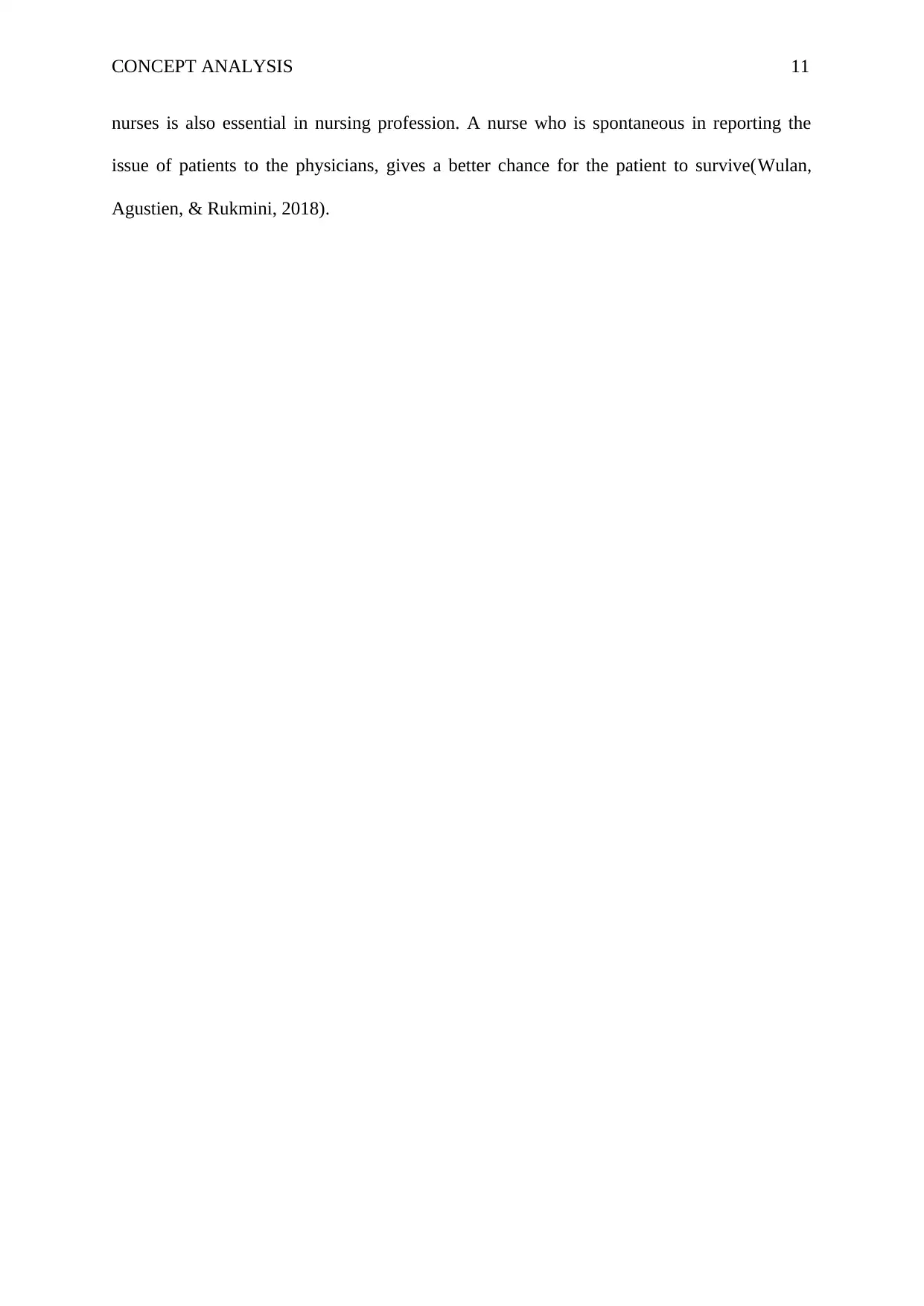
CONCEPT ANALYSIS 11
nurses is also essential in nursing profession. A nurse who is spontaneous in reporting the
issue of patients to the physicians, gives a better chance for the patient to survive(Wulan,
Agustien, & Rukmini, 2018).
nurses is also essential in nursing profession. A nurse who is spontaneous in reporting the
issue of patients to the physicians, gives a better chance for the patient to survive(Wulan,
Agustien, & Rukmini, 2018).
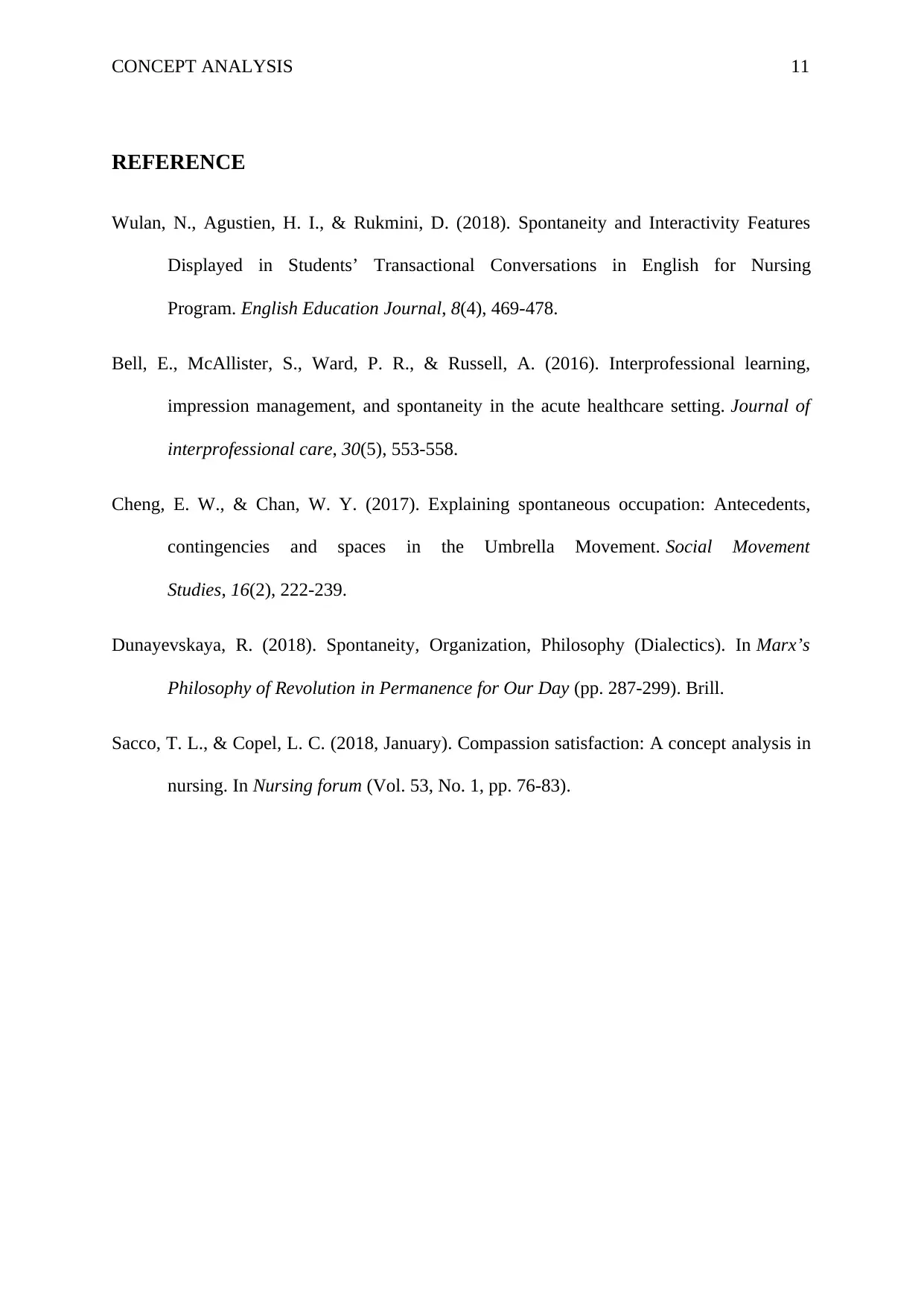
CONCEPT ANALYSIS 11
REFERENCE
Wulan, N., Agustien, H. I., & Rukmini, D. (2018). Spontaneity and Interactivity Features
Displayed in Students’ Transactional Conversations in English for Nursing
Program. English Education Journal, 8(4), 469-478.
Bell, E., McAllister, S., Ward, P. R., & Russell, A. (2016). Interprofessional learning,
impression management, and spontaneity in the acute healthcare setting. Journal of
interprofessional care, 30(5), 553-558.
Cheng, E. W., & Chan, W. Y. (2017). Explaining spontaneous occupation: Antecedents,
contingencies and spaces in the Umbrella Movement. Social Movement
Studies, 16(2), 222-239.
Dunayevskaya, R. (2018). Spontaneity, Organization, Philosophy (Dialectics). In Marx’s
Philosophy of Revolution in Permanence for Our Day (pp. 287-299). Brill.
Sacco, T. L., & Copel, L. C. (2018, January). Compassion satisfaction: A concept analysis in
nursing. In Nursing forum (Vol. 53, No. 1, pp. 76-83).
REFERENCE
Wulan, N., Agustien, H. I., & Rukmini, D. (2018). Spontaneity and Interactivity Features
Displayed in Students’ Transactional Conversations in English for Nursing
Program. English Education Journal, 8(4), 469-478.
Bell, E., McAllister, S., Ward, P. R., & Russell, A. (2016). Interprofessional learning,
impression management, and spontaneity in the acute healthcare setting. Journal of
interprofessional care, 30(5), 553-558.
Cheng, E. W., & Chan, W. Y. (2017). Explaining spontaneous occupation: Antecedents,
contingencies and spaces in the Umbrella Movement. Social Movement
Studies, 16(2), 222-239.
Dunayevskaya, R. (2018). Spontaneity, Organization, Philosophy (Dialectics). In Marx’s
Philosophy of Revolution in Permanence for Our Day (pp. 287-299). Brill.
Sacco, T. L., & Copel, L. C. (2018, January). Compassion satisfaction: A concept analysis in
nursing. In Nursing forum (Vol. 53, No. 1, pp. 76-83).
Paraphrase This Document
Need a fresh take? Get an instant paraphrase of this document with our AI Paraphraser
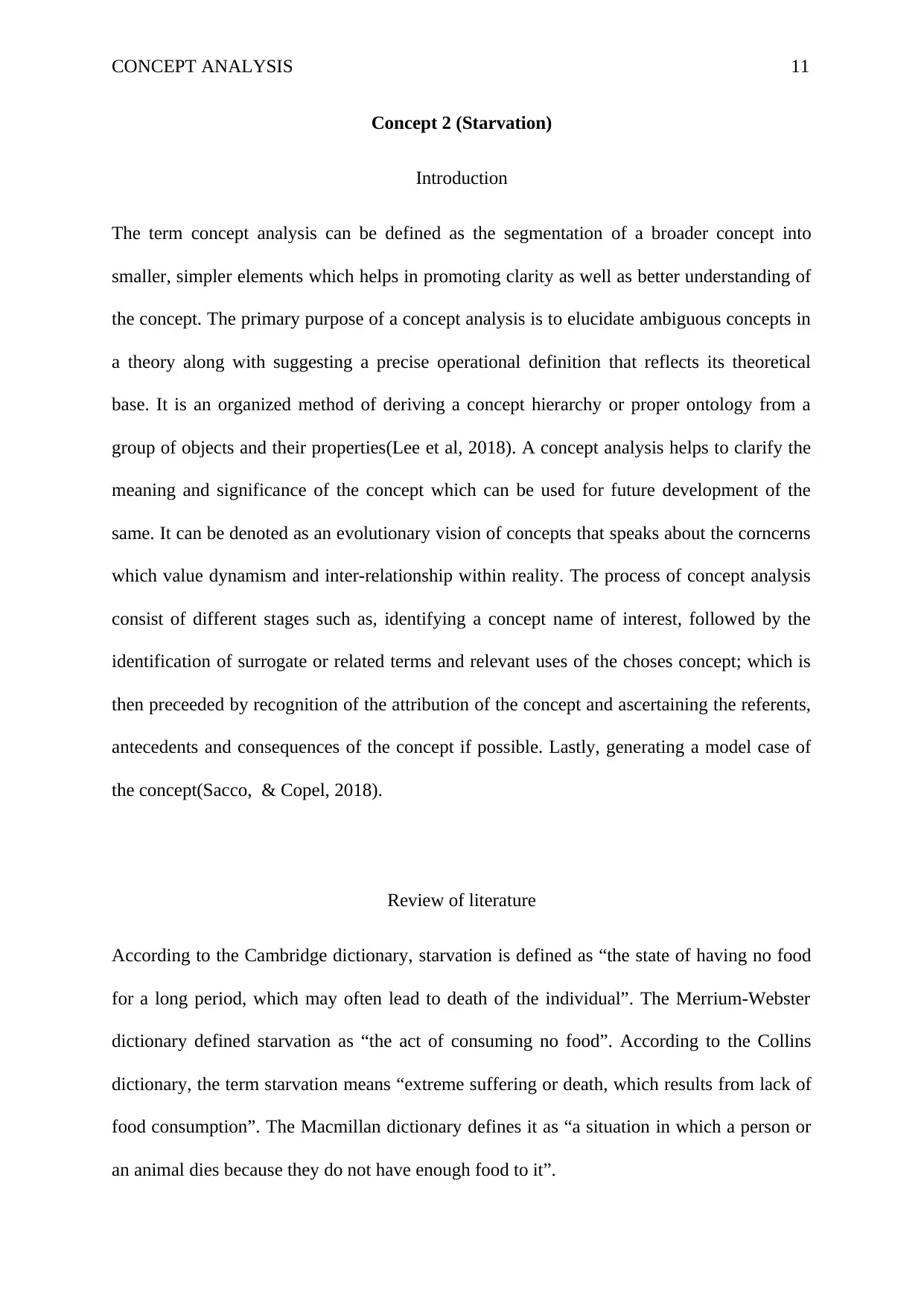
CONCEPT ANALYSIS 11
Concept 2 (Starvation)
Introduction
The term concept analysis can be defined as the segmentation of a broader concept into
smaller, simpler elements which helps in promoting clarity as well as better understanding of
the concept. The primary purpose of a concept analysis is to elucidate ambiguous concepts in
a theory along with suggesting a precise operational definition that reflects its theoretical
base. It is an organized method of deriving a concept hierarchy or proper ontology from a
group of objects and their properties(Lee et al, 2018). A concept analysis helps to clarify the
meaning and significance of the concept which can be used for future development of the
same. It can be denoted as an evolutionary vision of concepts that speaks about the corncerns
which value dynamism and inter-relationship within reality. The process of concept analysis
consist of different stages such as, identifying a concept name of interest, followed by the
identification of surrogate or related terms and relevant uses of the choses concept; which is
then preceeded by recognition of the attribution of the concept and ascertaining the referents,
antecedents and consequences of the concept if possible. Lastly, generating a model case of
the concept(Sacco, & Copel, 2018).
Review of literature
According to the Cambridge dictionary, starvation is defined as “the state of having no food
for a long period, which may often lead to death of the individual”. The Merrium-Webster
dictionary defined starvation as “the act of consuming no food”. According to the Collins
dictionary, the term starvation means “extreme suffering or death, which results from lack of
food consumption”. The Macmillan dictionary defines it as “a situation in which a person or
an animal dies because they do not have enough food to it”.
Concept 2 (Starvation)
Introduction
The term concept analysis can be defined as the segmentation of a broader concept into
smaller, simpler elements which helps in promoting clarity as well as better understanding of
the concept. The primary purpose of a concept analysis is to elucidate ambiguous concepts in
a theory along with suggesting a precise operational definition that reflects its theoretical
base. It is an organized method of deriving a concept hierarchy or proper ontology from a
group of objects and their properties(Lee et al, 2018). A concept analysis helps to clarify the
meaning and significance of the concept which can be used for future development of the
same. It can be denoted as an evolutionary vision of concepts that speaks about the corncerns
which value dynamism and inter-relationship within reality. The process of concept analysis
consist of different stages such as, identifying a concept name of interest, followed by the
identification of surrogate or related terms and relevant uses of the choses concept; which is
then preceeded by recognition of the attribution of the concept and ascertaining the referents,
antecedents and consequences of the concept if possible. Lastly, generating a model case of
the concept(Sacco, & Copel, 2018).
Review of literature
According to the Cambridge dictionary, starvation is defined as “the state of having no food
for a long period, which may often lead to death of the individual”. The Merrium-Webster
dictionary defined starvation as “the act of consuming no food”. According to the Collins
dictionary, the term starvation means “extreme suffering or death, which results from lack of
food consumption”. The Macmillan dictionary defines it as “a situation in which a person or
an animal dies because they do not have enough food to it”.
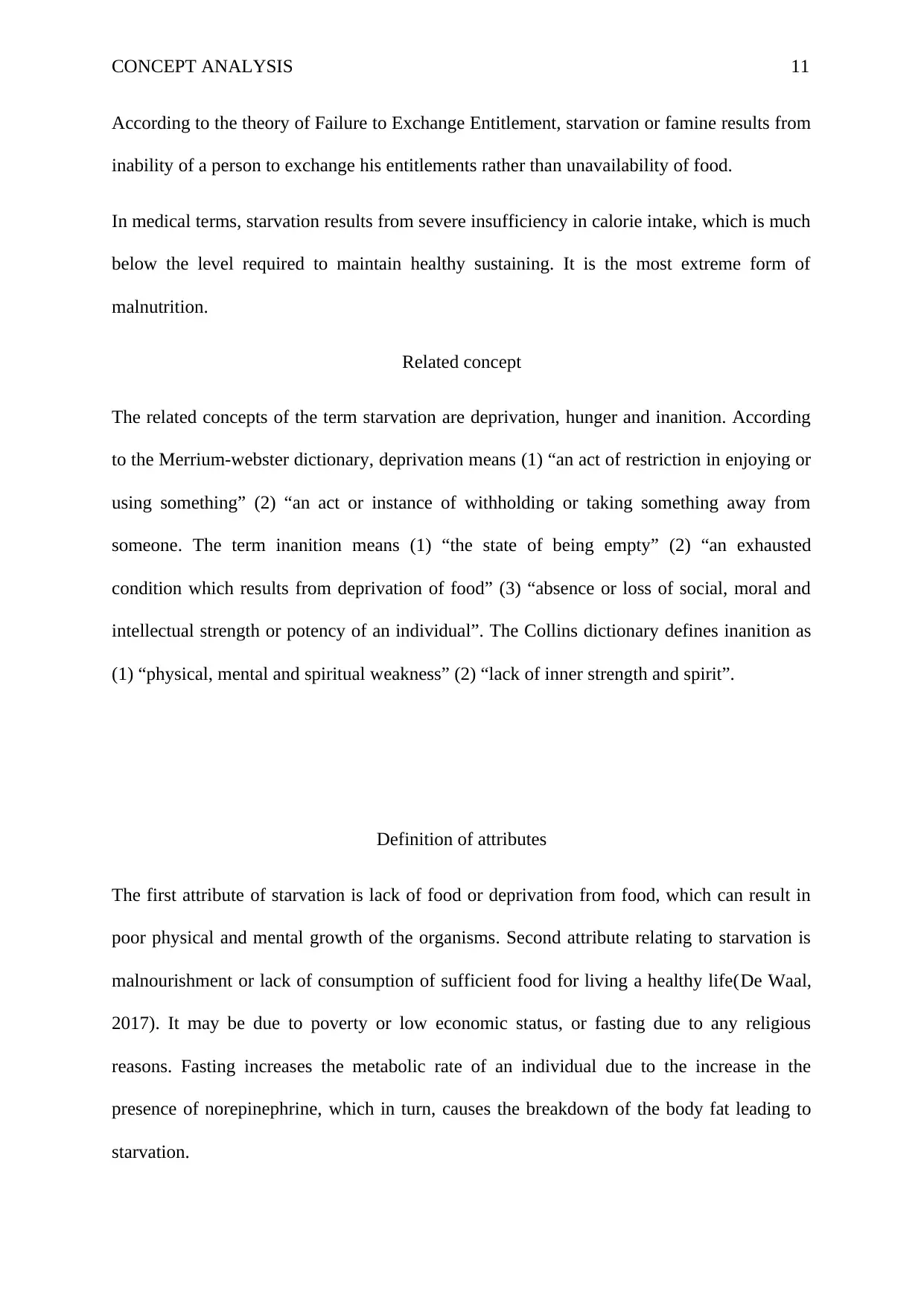
CONCEPT ANALYSIS 11
According to the theory of Failure to Exchange Entitlement, starvation or famine results from
inability of a person to exchange his entitlements rather than unavailability of food.
In medical terms, starvation results from severe insufficiency in calorie intake, which is much
below the level required to maintain healthy sustaining. It is the most extreme form of
malnutrition.
Related concept
The related concepts of the term starvation are deprivation, hunger and inanition. According
to the Merrium-webster dictionary, deprivation means (1) “an act of restriction in enjoying or
using something” (2) “an act or instance of withholding or taking something away from
someone. The term inanition means (1) “the state of being empty” (2) “an exhausted
condition which results from deprivation of food” (3) “absence or loss of social, moral and
intellectual strength or potency of an individual”. The Collins dictionary defines inanition as
(1) “physical, mental and spiritual weakness” (2) “lack of inner strength and spirit”.
Definition of attributes
The first attribute of starvation is lack of food or deprivation from food, which can result in
poor physical and mental growth of the organisms. Second attribute relating to starvation is
malnourishment or lack of consumption of sufficient food for living a healthy life(De Waal,
2017). It may be due to poverty or low economic status, or fasting due to any religious
reasons. Fasting increases the metabolic rate of an individual due to the increase in the
presence of norepinephrine, which in turn, causes the breakdown of the body fat leading to
starvation.
According to the theory of Failure to Exchange Entitlement, starvation or famine results from
inability of a person to exchange his entitlements rather than unavailability of food.
In medical terms, starvation results from severe insufficiency in calorie intake, which is much
below the level required to maintain healthy sustaining. It is the most extreme form of
malnutrition.
Related concept
The related concepts of the term starvation are deprivation, hunger and inanition. According
to the Merrium-webster dictionary, deprivation means (1) “an act of restriction in enjoying or
using something” (2) “an act or instance of withholding or taking something away from
someone. The term inanition means (1) “the state of being empty” (2) “an exhausted
condition which results from deprivation of food” (3) “absence or loss of social, moral and
intellectual strength or potency of an individual”. The Collins dictionary defines inanition as
(1) “physical, mental and spiritual weakness” (2) “lack of inner strength and spirit”.
Definition of attributes
The first attribute of starvation is lack of food or deprivation from food, which can result in
poor physical and mental growth of the organisms. Second attribute relating to starvation is
malnourishment or lack of consumption of sufficient food for living a healthy life(De Waal,
2017). It may be due to poverty or low economic status, or fasting due to any religious
reasons. Fasting increases the metabolic rate of an individual due to the increase in the
presence of norepinephrine, which in turn, causes the breakdown of the body fat leading to
starvation.
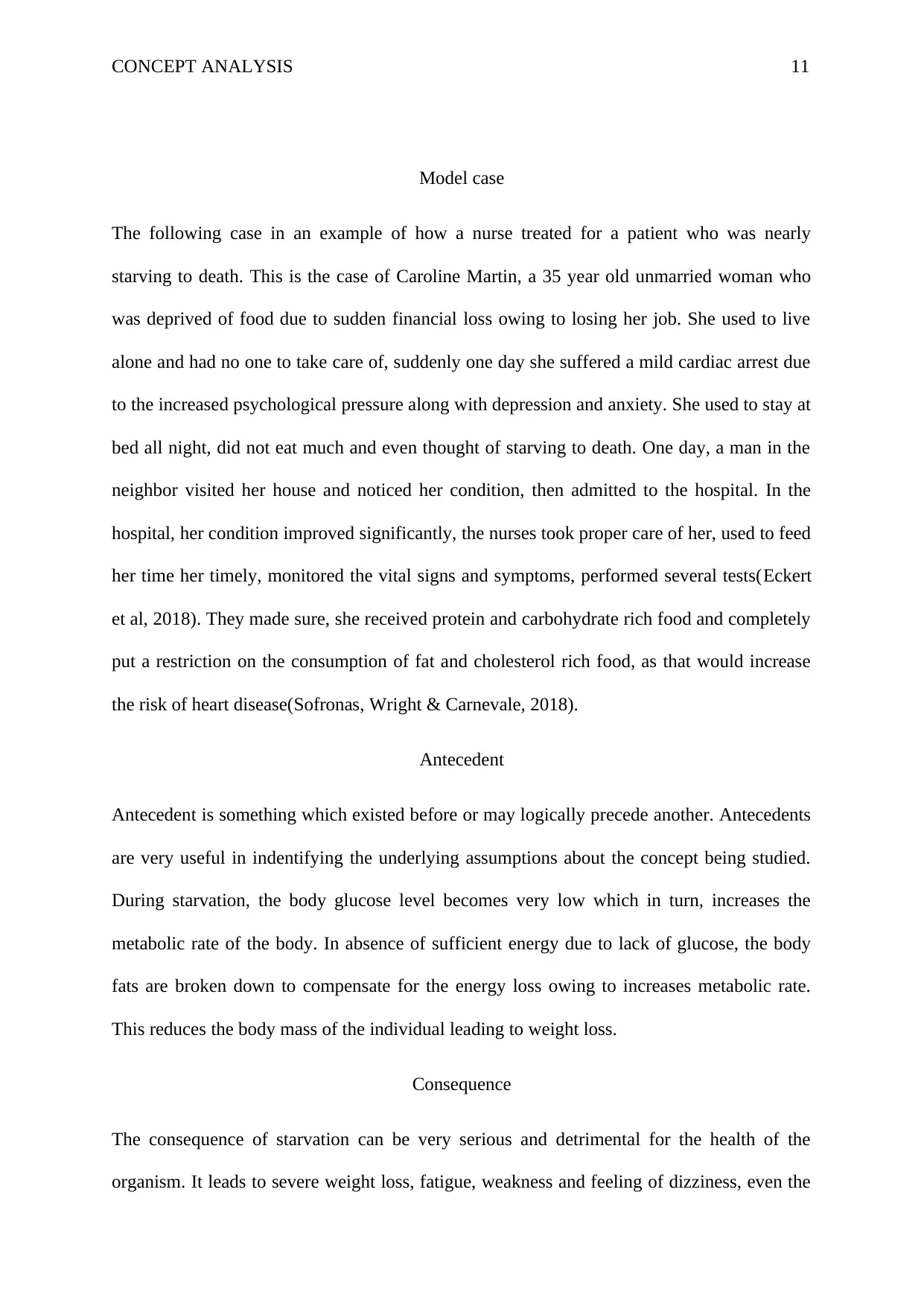
CONCEPT ANALYSIS 11
Model case
The following case in an example of how a nurse treated for a patient who was nearly
starving to death. This is the case of Caroline Martin, a 35 year old unmarried woman who
was deprived of food due to sudden financial loss owing to losing her job. She used to live
alone and had no one to take care of, suddenly one day she suffered a mild cardiac arrest due
to the increased psychological pressure along with depression and anxiety. She used to stay at
bed all night, did not eat much and even thought of starving to death. One day, a man in the
neighbor visited her house and noticed her condition, then admitted to the hospital. In the
hospital, her condition improved significantly, the nurses took proper care of her, used to feed
her time her timely, monitored the vital signs and symptoms, performed several tests(Eckert
et al, 2018). They made sure, she received protein and carbohydrate rich food and completely
put a restriction on the consumption of fat and cholesterol rich food, as that would increase
the risk of heart disease(Sofronas, Wright & Carnevale, 2018).
Antecedent
Antecedent is something which existed before or may logically precede another. Antecedents
are very useful in indentifying the underlying assumptions about the concept being studied.
During starvation, the body glucose level becomes very low which in turn, increases the
metabolic rate of the body. In absence of sufficient energy due to lack of glucose, the body
fats are broken down to compensate for the energy loss owing to increases metabolic rate.
This reduces the body mass of the individual leading to weight loss.
Consequence
The consequence of starvation can be very serious and detrimental for the health of the
organism. It leads to severe weight loss, fatigue, weakness and feeling of dizziness, even the
Model case
The following case in an example of how a nurse treated for a patient who was nearly
starving to death. This is the case of Caroline Martin, a 35 year old unmarried woman who
was deprived of food due to sudden financial loss owing to losing her job. She used to live
alone and had no one to take care of, suddenly one day she suffered a mild cardiac arrest due
to the increased psychological pressure along with depression and anxiety. She used to stay at
bed all night, did not eat much and even thought of starving to death. One day, a man in the
neighbor visited her house and noticed her condition, then admitted to the hospital. In the
hospital, her condition improved significantly, the nurses took proper care of her, used to feed
her time her timely, monitored the vital signs and symptoms, performed several tests(Eckert
et al, 2018). They made sure, she received protein and carbohydrate rich food and completely
put a restriction on the consumption of fat and cholesterol rich food, as that would increase
the risk of heart disease(Sofronas, Wright & Carnevale, 2018).
Antecedent
Antecedent is something which existed before or may logically precede another. Antecedents
are very useful in indentifying the underlying assumptions about the concept being studied.
During starvation, the body glucose level becomes very low which in turn, increases the
metabolic rate of the body. In absence of sufficient energy due to lack of glucose, the body
fats are broken down to compensate for the energy loss owing to increases metabolic rate.
This reduces the body mass of the individual leading to weight loss.
Consequence
The consequence of starvation can be very serious and detrimental for the health of the
organism. It leads to severe weight loss, fatigue, weakness and feeling of dizziness, even the
Secure Best Marks with AI Grader
Need help grading? Try our AI Grader for instant feedback on your assignments.
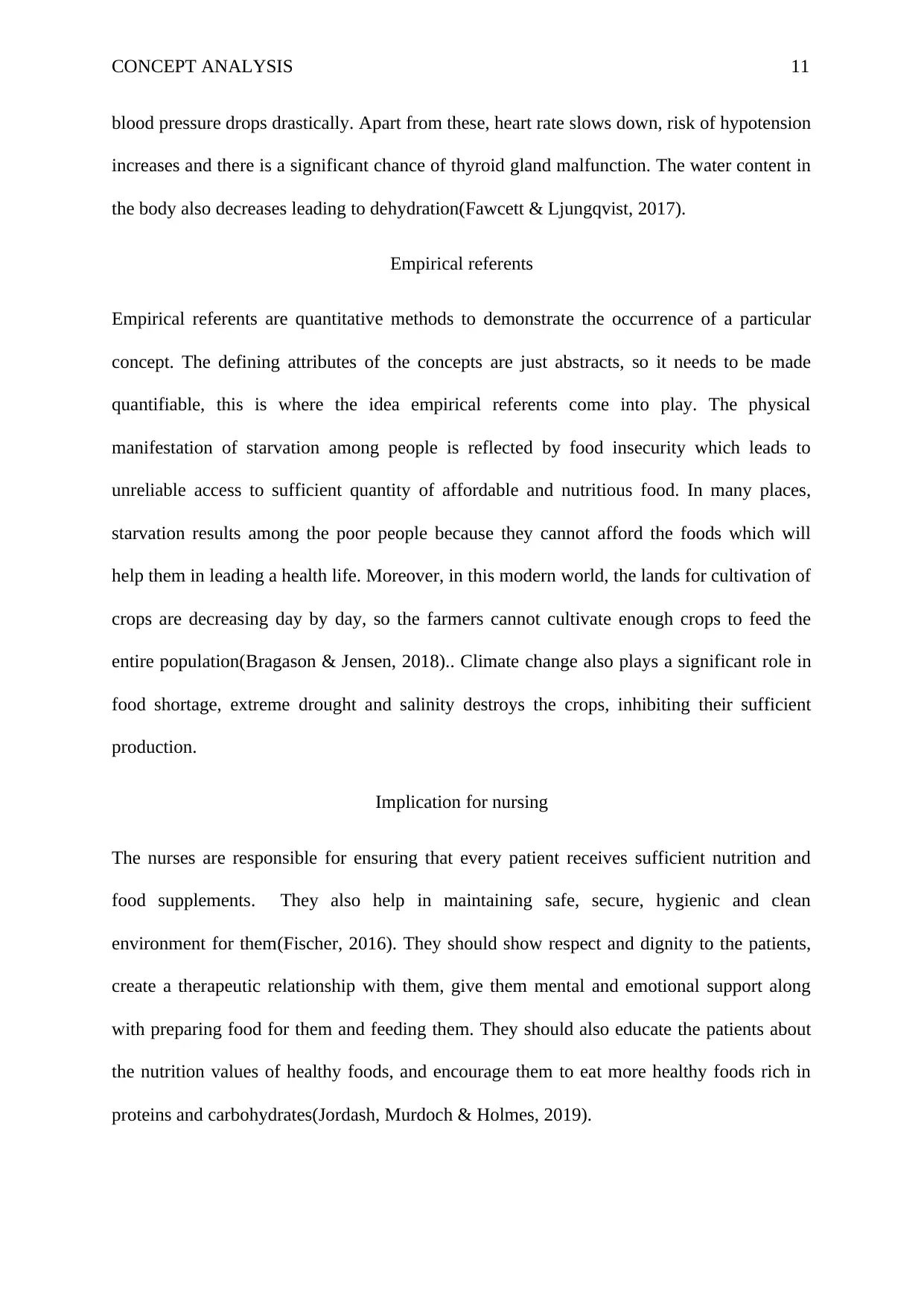
CONCEPT ANALYSIS 11
blood pressure drops drastically. Apart from these, heart rate slows down, risk of hypotension
increases and there is a significant chance of thyroid gland malfunction. The water content in
the body also decreases leading to dehydration(Fawcett & Ljungqvist, 2017).
Empirical referents
Empirical referents are quantitative methods to demonstrate the occurrence of a particular
concept. The defining attributes of the concepts are just abstracts, so it needs to be made
quantifiable, this is where the idea empirical referents come into play. The physical
manifestation of starvation among people is reflected by food insecurity which leads to
unreliable access to sufficient quantity of affordable and nutritious food. In many places,
starvation results among the poor people because they cannot afford the foods which will
help them in leading a health life. Moreover, in this modern world, the lands for cultivation of
crops are decreasing day by day, so the farmers cannot cultivate enough crops to feed the
entire population(Bragason & Jensen, 2018).. Climate change also plays a significant role in
food shortage, extreme drought and salinity destroys the crops, inhibiting their sufficient
production.
Implication for nursing
The nurses are responsible for ensuring that every patient receives sufficient nutrition and
food supplements. They also help in maintaining safe, secure, hygienic and clean
environment for them(Fischer, 2016). They should show respect and dignity to the patients,
create a therapeutic relationship with them, give them mental and emotional support along
with preparing food for them and feeding them. They should also educate the patients about
the nutrition values of healthy foods, and encourage them to eat more healthy foods rich in
proteins and carbohydrates(Jordash, Murdoch & Holmes, 2019).
blood pressure drops drastically. Apart from these, heart rate slows down, risk of hypotension
increases and there is a significant chance of thyroid gland malfunction. The water content in
the body also decreases leading to dehydration(Fawcett & Ljungqvist, 2017).
Empirical referents
Empirical referents are quantitative methods to demonstrate the occurrence of a particular
concept. The defining attributes of the concepts are just abstracts, so it needs to be made
quantifiable, this is where the idea empirical referents come into play. The physical
manifestation of starvation among people is reflected by food insecurity which leads to
unreliable access to sufficient quantity of affordable and nutritious food. In many places,
starvation results among the poor people because they cannot afford the foods which will
help them in leading a health life. Moreover, in this modern world, the lands for cultivation of
crops are decreasing day by day, so the farmers cannot cultivate enough crops to feed the
entire population(Bragason & Jensen, 2018).. Climate change also plays a significant role in
food shortage, extreme drought and salinity destroys the crops, inhibiting their sufficient
production.
Implication for nursing
The nurses are responsible for ensuring that every patient receives sufficient nutrition and
food supplements. They also help in maintaining safe, secure, hygienic and clean
environment for them(Fischer, 2016). They should show respect and dignity to the patients,
create a therapeutic relationship with them, give them mental and emotional support along
with preparing food for them and feeding them. They should also educate the patients about
the nutrition values of healthy foods, and encourage them to eat more healthy foods rich in
proteins and carbohydrates(Jordash, Murdoch & Holmes, 2019).
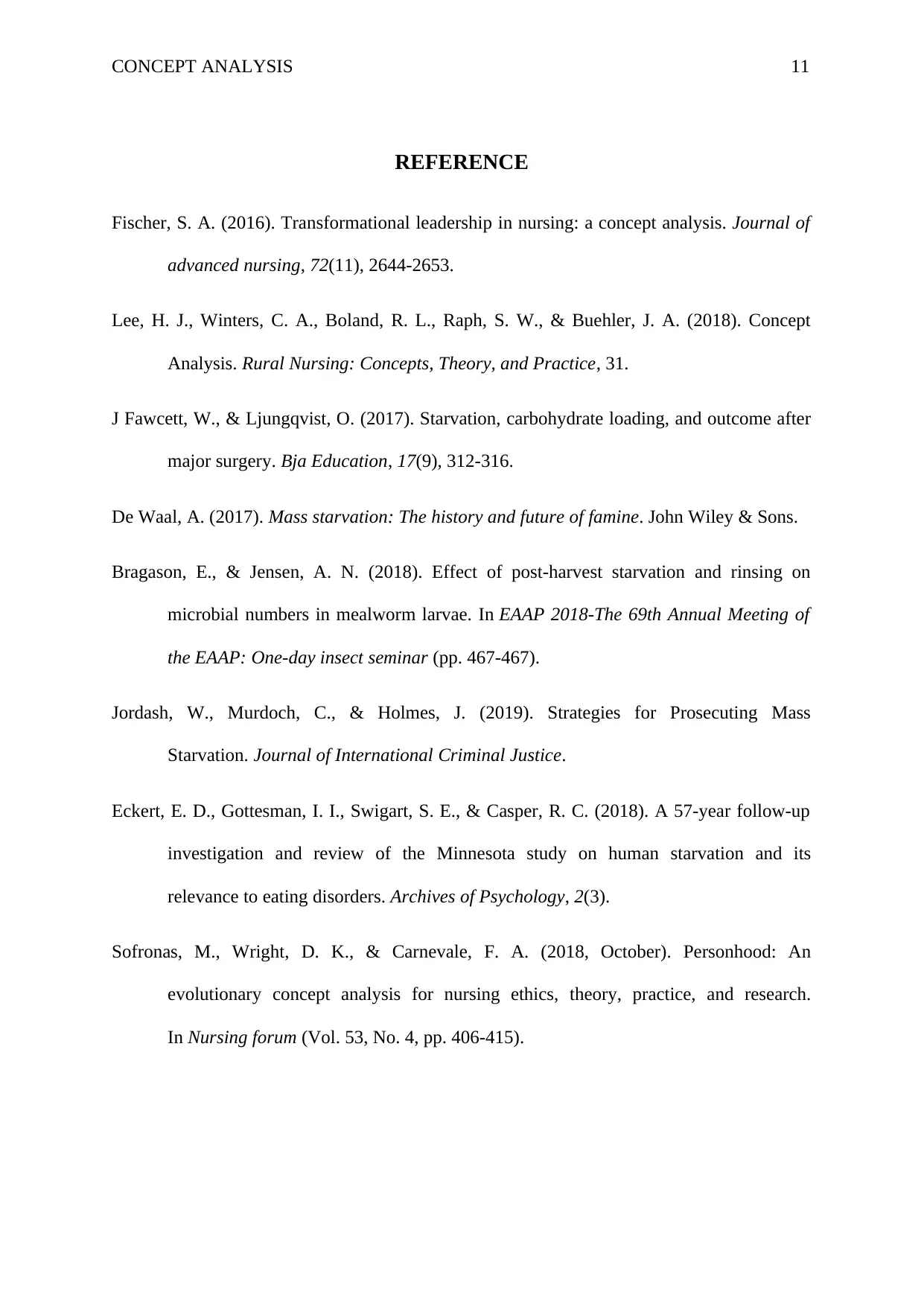
CONCEPT ANALYSIS 11
REFERENCE
Fischer, S. A. (2016). Transformational leadership in nursing: a concept analysis. Journal of
advanced nursing, 72(11), 2644-2653.
Lee, H. J., Winters, C. A., Boland, R. L., Raph, S. W., & Buehler, J. A. (2018). Concept
Analysis. Rural Nursing: Concepts, Theory, and Practice, 31.
J Fawcett, W., & Ljungqvist, O. (2017). Starvation, carbohydrate loading, and outcome after
major surgery. Bja Education, 17(9), 312-316.
De Waal, A. (2017). Mass starvation: The history and future of famine. John Wiley & Sons.
Bragason, E., & Jensen, A. N. (2018). Effect of post-harvest starvation and rinsing on
microbial numbers in mealworm larvae. In EAAP 2018-The 69th Annual Meeting of
the EAAP: One-day insect seminar (pp. 467-467).
Jordash, W., Murdoch, C., & Holmes, J. (2019). Strategies for Prosecuting Mass
Starvation. Journal of International Criminal Justice.
Eckert, E. D., Gottesman, I. I., Swigart, S. E., & Casper, R. C. (2018). A 57-year follow-up
investigation and review of the Minnesota study on human starvation and its
relevance to eating disorders. Archives of Psychology, 2(3).
Sofronas, M., Wright, D. K., & Carnevale, F. A. (2018, October). Personhood: An
evolutionary concept analysis for nursing ethics, theory, practice, and research.
In Nursing forum (Vol. 53, No. 4, pp. 406-415).
REFERENCE
Fischer, S. A. (2016). Transformational leadership in nursing: a concept analysis. Journal of
advanced nursing, 72(11), 2644-2653.
Lee, H. J., Winters, C. A., Boland, R. L., Raph, S. W., & Buehler, J. A. (2018). Concept
Analysis. Rural Nursing: Concepts, Theory, and Practice, 31.
J Fawcett, W., & Ljungqvist, O. (2017). Starvation, carbohydrate loading, and outcome after
major surgery. Bja Education, 17(9), 312-316.
De Waal, A. (2017). Mass starvation: The history and future of famine. John Wiley & Sons.
Bragason, E., & Jensen, A. N. (2018). Effect of post-harvest starvation and rinsing on
microbial numbers in mealworm larvae. In EAAP 2018-The 69th Annual Meeting of
the EAAP: One-day insect seminar (pp. 467-467).
Jordash, W., Murdoch, C., & Holmes, J. (2019). Strategies for Prosecuting Mass
Starvation. Journal of International Criminal Justice.
Eckert, E. D., Gottesman, I. I., Swigart, S. E., & Casper, R. C. (2018). A 57-year follow-up
investigation and review of the Minnesota study on human starvation and its
relevance to eating disorders. Archives of Psychology, 2(3).
Sofronas, M., Wright, D. K., & Carnevale, F. A. (2018, October). Personhood: An
evolutionary concept analysis for nursing ethics, theory, practice, and research.
In Nursing forum (Vol. 53, No. 4, pp. 406-415).
1 out of 12
Related Documents
Your All-in-One AI-Powered Toolkit for Academic Success.
+13062052269
info@desklib.com
Available 24*7 on WhatsApp / Email
![[object Object]](/_next/static/media/star-bottom.7253800d.svg)
Unlock your academic potential
© 2024 | Zucol Services PVT LTD | All rights reserved.





